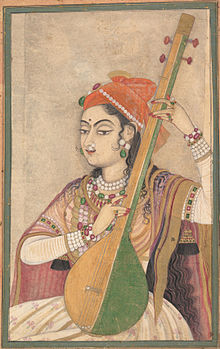Music of Karnataka
| Music of India | |
|---|---|

A Lady Playing the Tanpura, ca. 1735 (Rajasthan)
|
|
| Genres | |
|
|
| Media and performance | |
| Music awards | |
| Music festivals | |
| Music media | |
| Nationalistic and patriotic songs | |
| National anthem | Jana Gana Mana |
| Regional music | |
|
|
Karnataka is a state of India with a long tradition of innovation in the fields of both Carnatic and Hindustani classical music.
Basaveshwara, King of Kalyana, leader of the Bhakti movement and Prime Minister of Bijjala, created his Vachanas, an integral part of the Indian classical music's development during this period, which also saw the rise of composers like Chandraja, Shantala, Akka Mahadevi and Allama. Later, Vidyaranya's Sangitasara, Ventamakhin's Chaturdandi Prakashika and Chaturkallinatha's Sangitaratnakara further refined these traditions.
With the rise of Vaishnavism and the Haridasa movement came prominent composers from Karnataka like Purandaradasa, Kanakadasa, Vijaya Dasa and Jagannathadasa. The Wodeyars of Mysore were great patrons of the arts.
In earlier times, Sangeeta Shaastra followed the “Guru-Shishya” tradition, and there did not exist any written text. First classical music began as abhyasa, and it was only later that shaastras were formed. It is estimated that only during the period of Bharatamuni (300 BC) were the theories of sangeeta documented for the first time, and this was termed as “Naatya Shaastra”. For a considerable period of time it was one of the only authoritative treatise (PramaaNa Grantha) for the whole of India. After that, independent growth of classical music occurred across different parts of India, in different forms.
...
Wikipedia
